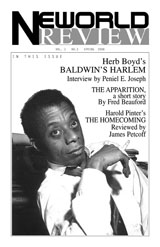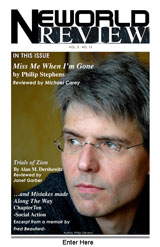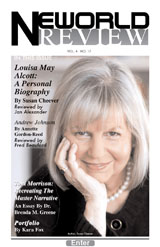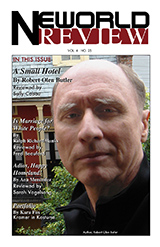This Month's Articles
REVIEWING
Storm of the i: An Artobiography
by Tina Collen
Reviewed by Sarah Vogelsong
Eight words emblazon the cover of Tina Collen’s first book, Storm of the i: An Artobiography, and two are plays on words. The first is easy to find, a narrow line and a dot floating in light italics above a woman’s eyeball peering through a cutout. The second is easier to overlook but far more important—not autobiography, or story of the self--but artobiography, a story of art, told through art.
This memoir is unusual. Framed around the ups and downs of her troubled relationship with her father, Collen’s book could easily have been banal in less deft or more conventional hands. But Collen, an artist and graphic designer, understands what so many memoirists do not: that pain, family, and the search for love and acceptance are universal experiences, and that these struggles are best.....Read More
PORTFOLIO
Portfolio: The fascinating world of Rocky Salskov
by Kara Fox
Engaged to my second husband, who excelled in advertising and promotion, we, my children and I, were to become a full-page spread on the back page of a Hollywood publication. The photographer he selected to capture our happy faces was Rocky Salskov. And that was my introduction to this unique artist.
Rocky first fell in love with photography while studying architecture at the University of Washington where he tried a photography course within the architecture department. It was his good fortune to discover this class, for it was taught by Christian Staub, a brilliant German Swiss, who had studied and taught with some of the most influential artists in Europe in the late 30's & 40's. He became Rocky's mentor.
While studying at the U.W., his enthusiasm for art/photography grew. He read tirelessly about every.....Read More
REVIEWING
Fiction Ruined My Family: A Memoir
by Jeanne Darst
Reviewed by Emily Rosen
Jeanne Darst’s breezy style is at first somewhat off-putting (“Mom was an awfully swell looking lady,” “I heard Don DeLillo lived in town (Bronxville, N.Y.) but I never saw his ass.”), but she does display some Dave Barry type wit, and as she chronicles her adventures as a high-wired kid with ludicrously bad judgment, she includes dollops of insightful writinghidden in its creases.
Jeanne is the youngest of four daughters, “a book hater, an accomplished reader, a paperwork junkie, and (Jeanne as a child) an idiot detective.” The family lived in St. Louis until Dad moved them to Bronxville, New York.
Her mother is a major la dee dah. Nee Doris Grissy. she came from a stock of debutantes and prosperity and was the youngest person, as a child equestrian, to be on the cover of Sports Illustrated, in 1956. Her father, Stephen Darst, is an eternally hopeful freelance writer. He has yet to sell a book, and is perennially working on one about the life of F. Scott Fitzgerald and his wife, Zelda, which proves to be an underlying core theme that Jeanne struggles to.....Read More
REVIEWING
The Blind Alley
by Grace Edwards
Reviewed by Herb Boyd
Anticipating the ways Grace Edwards will evoke Harlem is one thing her fans relish from her novels, particularly those denizens of the storied community. But even for those who don’t reside there, Edwards knows how to seduce her readers and to make Harlem and its various neighborhoods seem almost like other characters.
Five years ago, in her book The Viaduct, Edwards offered this image of the famous jazz joint, Minton’s. One of her main characters remembered sitting at the bar when Thelonious Monk strolled in after his gig at the Five Spot in downtown Manhattan. “She watched him lean over the keys, close his eyes, and run his fingers down the chords,” Edwards wrote. “The other musicians struck up but Monk played as if he were alone in the place, listening to notes that only he seemed to hear. There were solos and duets and the crowd sat spellbound till dawn. It was hard getting .....Read More
REVIEWING
The Better Angels of Our Nature—Why Violence Has Declined
by Steven Pinker
Reviewed by Jane M McCabe
I was mad at Dr. Steven Pinker for having written such a long book—696 pages of text, 40 pages of 8 point footnotes, 32 pages of 8 point references and an index 29 pages long! Talk about a weighty tome. I couldn’t lie in bed and hold it on my chest.
I can’t deny, however, that Dr. Pinker presents a convincing argument that violence has declined in the modern world. In the past things were much worse—during the Roman Empire and Spanish Inquisition, with their auto-de-fe’s, people enjoyed watching others being tortured and killed.....Read More
Letters to the Editor
Dear Fred:
Thanks for the heads-up, Fred. I have to say that was perhaps the most thoughtful and insightful and lovely review I've had of this book (A Small Hotel, reviewed by Sally Cobau). Please give my sincere thanks to the reviewer.
All the best. And congratulations on the splendid magazine.
Best,
Robert Olen Butler
Dear Fred:
To be perfectly frank, I was very much surprised, even shocked as all hell to see something like this coming from an American publication, online or offline, which is why I am writing you. Everyone knows that this kind of talk is just not allowed in the land of “free speech.”
Fred Beauford demonstrated great intellectual courage and insight in his review, Is Marriage for White People? by Ralph Richard Banks.
However, when he talks about the ”conservative backlash” of Cultural Nationalism to the successes of the Civil Rights Movement, he could have pointed out that it was non-African American “black” males like Colin Powell, Eric Holder and President Obama that took full advantage to these successes, even as ethnic African American men were firmly put back in their place, leaving the clerics once more in charge.
It will be interesting to note how native blacks will react to someone like a Herman Cain, a true African American, and a dark one to boot, with a powerbase outside of traditional standards of black political expressions.
James P. Johnson, Ph.D.
Visiting Professor of History and American Studies
American University of Beirut
REVIEWING
Binocular Vision
by Edith Pearlman
Reviewed by Sally Cobau
Old World and New
Edith Pearlman’s stories are witty, sly, and full of life, not to mention refreshingly free of cliché’s and platitudes. They also vary in scene, character, and temperament to an astonishing degree. In her latest collection, Binocular Vision—a beautifully designed book by Lookout Books--these traits are displayed in abundance. In one story, one might find a child genius navigating the subway system in Boston; in another, the reader is taken to a foreign country and led almost warily by the hand of a jaded ex-patriot.
Her characters are not timid—they go about their business with a.....Read More
REVIEWING
Always Plenty To Do: Growing up on a Farm in the Long Ago
by Pamela Riney-Kehrberg
Reviewed by Fred Beauford
Although this slim volume is for young readers, I was drawn to it for many reasons, one of which was because I had personally lived some of what Professor Pamela Riney-Kehrberg describes in her book (You can find my account at Neworld Review, No. 5, Chapter One of my memoir, And Mistakes Made Along the Way "The Morton's of Virginia"). I was familiar first hand with slopping the hogs, outhouses, pulling weeds, milking cows, drawing water from the well, wringing the head off a chicken, chopping wood, and gathering whatever food we could through fishing, hunting and poaching, if the case called for it. We had great food.....Read More
REVIEWING
Harlem Renaissance Four Novels of the 1930s
The Library of America Collection
Edited by Rafia Zafar
Reviewed by Loretta H. Campbell
New Beginnings
“Suddenly the aged Negro dropped to one knee, his hands resting on the arm of the planter’s [master’s] chair, and began weeping aloud.” This is a passage from Black Thunder, by Arna Bontemps, and one of the four novels in this extraordinary volume, a companion to Harlem Renaissance Five Novels of the 1920s, also edited by Rafia Zafar(author of We Wear the Masks).
In this section, Ben, a house slave in southeastern Virginia during the 1800s, betrays a slave insurrection, condemning hundreds of his brothers and sisters to horrible deaths.
Bontemps describes Ben as the aged house slave/butler who believed his master’s life and comfort were more valuable than the lives of Ben’s own people. In short, Ben was exactly as his master described him, “a good boy.”
Unfortunately, the leaders of the insurrection believed that Ben and another slave were trustworthy. Bontemps gives us an intimate portrait of Ben’s mindset and that.....Read More
NOVEL
The African Gentleman
…and The Plot to Re-establish The New World Order
A Novel by Fred Beauford
Chapters 34-35
34
My life has continued to be eventful ever since Gladys and I met in that bar in The Village, parts of which I have really liked. Eric and Gladys are fun and interesting, but other parts I am not sure about. Assai may be history, but the organization he is alleged to be the head of seems to be alive and well, and scaring the living shit out of everyone.
Just the other day I was about halfway down the steps, heading for the train to take me across The River, when I heard an explosion. Boom! I had never heard a sound so loud in my life. Yet it still sounded strangely muffled, and some distance away.
People started running past me, an excited, panicked look on their faces,.....Read More
REVIEWING
Singing to the Plants: A Guide to Mestizo Shamanism in the Upper Amazon
by Stephan V. Beyer
Reviewed by Barbara Snow
“Ayahuasca is a plant which has the effect that when you drink it, it allows you to see what otherwise is invisible, and it attracts the spirits. It is not that the ayahuasca takes one to another world, otherwise unreachable; it just opens one’s eyes to what is normally hidden. There is only one world, which is shared by all beings, humans, spirits, and animals.” ~ Anthropologist Marie Perruchon, married to a Shuar husband and an initiated uwishin. (Pg. 37, Singing to the Plants)
“The territory occupied by the shaman is suffering, hope, failure, envy, spite and malice.” (Pg. 45, Singing to the Plants)
Human consciousness is no less complex in the Amazon than it is in New York city. In Singing to the Plants, Dr. Stephan Beyers undertakes a thorough and clear-eyed investigation into the nature of the ailments of all humans, and the ways in which we experience healing. Healthy skepticism concedes to sometimes extraordinary.....Read More
A WRITER'S WORLD
Nothing Good comes from A Blank Page
by Molly Moynahan
"Every creator painfully experiences the chasm between his inner vision and its ultimate expression." Isaac Bashevis Singer
"You can't rely on inspiration. I don't even believe in inspiration. I just believe in working. Work generates work. What frustrates me horribly is not knowing what I'm going to do next. And so you force something to happen. . . . You can't sit around thinking. You have to sit around working." David Long
I have never had writer’s block. I’m not actually sure what it means not to be able to write. One of my ex-boyfriend’s once said, “You are totally.....Read More
REVIEWING
The Leftovers
by Tom Perrotta
Reviewed by Michael Carey
Imagine the rapture has just occurred. You left your family in one room or looked away from your friend to watch a video (or read a review) on the computer screen only to find that when you look back they are gone. You are now one of the Leftovers. What do you do? How do you go forward?
Tom Perrotta’s novel, The Leftovers, explores a world where this happens. With no rhyme or reason to explain how or why it happened or who was chosen and why, the city of Mapleton tries to deal with the tragedy. The Garvey family, Kevin, Laurie, Jill, and Tom, although all left behind, struggle independently to find their path and make sense of the world. The paths taken by the family members and other town citizens are unique to the characters and quite diverse, ranging from cults to becoming the mayor as a member of the “Hopeful Party”.
The Leftovers poses a serious question in an age.....Read More

























